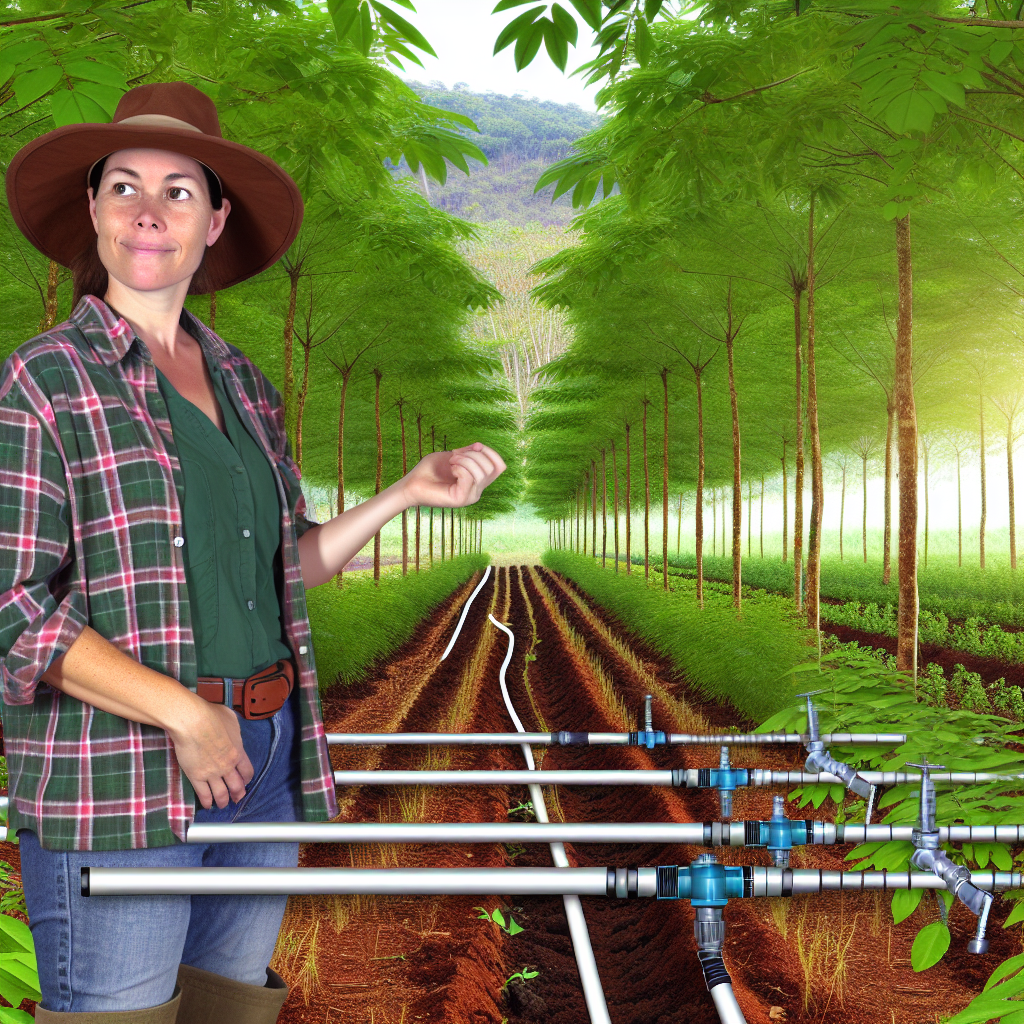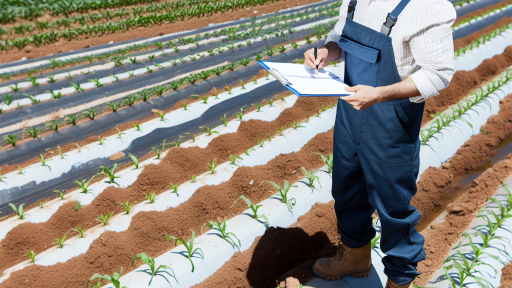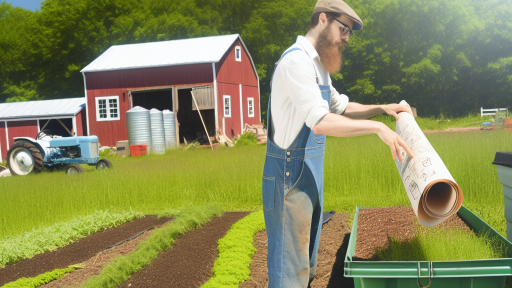Introduction to Agroforestry and Its Role in Water Efficiency
Agroforestry integrates trees and shrubs into agricultural landscapes.
This practice enhances biodiversity and improves soil health.
Moreover, it plays a pivotal role in achieving water efficiency.
Understanding Agroforestry
Agroforestry systems combine agricultural crops with woody perennials.
These systems can vary widely in design and functionality.
For instance, farmers may plant trees alongside their crops.
This integration helps to create a sustainable farming environment.
Benefits for Water Management
Agroforestry promotes water conservation in multiple ways.
Firstly, deep-rooted trees access water from deeper soil layers.
This reduces surface runoff and erosion significantly.
Secondly, tree canopies slow down rainfall, allowing more water to infiltrate.
As a result, the soil retains moisture better.
Agroforestry Practices Enhancing Water Efficiency
Several specific practices exist within agroforestry to boost water efficiency.
Contour Planting
This method involves planting along the contours of the land.
It effectively reduces water runoff and soil erosion.
Transform Your Agribusiness
Unlock your farm's potential with expert advice tailored to your needs. Get actionable steps that drive real results.
Get StartedAdditionally, it promotes water retention in the landscape.
Buffer Strips
Buffer strips consist of trees or shrubs planted near water bodies.
These strips filter pollutants and improve water quality.
They also stabilize the soil along banks, reducing erosion.
Alley Cropping
In alley cropping, crops grow in the spaces between tree rows.
This practice allows for greater biodiversity and resource utilization.
Furthermore, it improves water availability for crops.
Implementing Agroforestry for Enhanced Water Efficiency
Farmers can implement agroforestry to enhance water resource management.
Choosing Suitable Tree Species
Selecting the right tree species is crucial for success.
Native species typically provide the best results.
They adapt well to local conditions and require less maintenance.
Training and Support for Farmers
Providing educational resources helps farmers understand agroforestry.
Workshops and support networks can facilitate knowledge sharing.
Access to expert guidance ensures the best practices are followed.
Monitoring and Adaptation
Active monitoring of water usage and soil health is essential.
Farmers can adjust practices based on observed outcomes.
This adaptive approach leads to continuous improvement.
Benefits of Integrating Trees in Agricultural Systems for Water Conservation
Enhancing Soil Moisture Retention
Integrating trees increases soil moisture retention significantly.
This practice reduces evaporation rates from the soil surface.
Moreover, trees provide shade that protects soil from direct sunlight.
As a result, crops benefit from improved moisture availability.
Overall, better moisture management boosts crop resilience during dry spells.
Reducing Water Runoff and Erosion
Trees help reduce water runoff in agricultural landscapes.
They create a natural barrier that slows down water flow.
Showcase Your Farming Business
Publish your professional farming services profile on our blog for a one-time fee of $200 and reach a dedicated audience of farmers and agribusiness owners.
Publish Your ProfileThis slows erosion, preserving topsoil and nutrients.
Consequently, soil remains healthier for longer periods.
Additionally, reduced runoff minimizes the risk of pollution in nearby water sources.
Promoting Biodiversity
Agroforestry encourages a diverse range of plant and animal species.
Trees provide habitats for various wildlife, enhancing ecosystem health.
Biodiversity improves soil structure and nutrient cycling.
Furthermore, promoting a balanced ecosystem strengthens crop resilience.
Healthy ecosystems can better withstand the effects of climate change.
Improving Water Quality
Integrating trees reduces nutrient and pesticide runoff into waterways.
Tree roots filter pollutants before they reach water sources.
As a result, this leads to cleaner and healthier water supplies.
The presence of trees also stabilizes riverbanks and reduces sedimentation.
Ultimately, improved water quality benefits both agriculture and local communities.
Enhancing Microclimates
Trees play a vital role in creating beneficial microclimates.
They provide shade, which helps regulate temperature for crops.
A cooler microclimate can reduce heat stress on plants.
Moreover, trees increase humidity levels, benefiting moisture-sensitive crops.
Such conducive environments promote healthier crop growth and yield.
Types of Agroforestry Practices
Alley Cropping
Alley cropping involves planting rows of trees alongside agricultural crops.
This practice enhances crop yields while promoting biodiversity.
Farmers can optimize land use through the strategic arrangement of crops and trees.
Additionally, trees provide shade and shelter for crops, reducing heat stress.
Moreover, alley cropping improves soil structure with organic matter from tree litter.
This approach increases soil moisture retention, critical for water efficiency.
Farmers can enhance overall productivity by integrating diverse plant species.
Ultimately, alley cropping supports sustainable agricultural practices.
Silvopasture
Silvopasture combines trees, pasture, and livestock on the same land.
This practice promotes a symbiotic relationship among the components.
Livestock benefit from shade and forage provided by trees.
In return, animal waste enriches the soil, supporting tree growth.
Furthermore, silvopasture can reduce soil erosion and improve water infiltration.
This method enhances biodiversity and provides multiple revenue streams for farmers.
Overall, silvopasture is an effective strategy for sustainable land management.
Windbreaks
Windbreaks consist of trees planted in rows to protect crops and livestock.
They help reduce wind speed, improving microclimate for sensitive plants.
Additionally, windbreaks minimize soil erosion by stabilizing the earth.
They can also decrease evaporation, thus preserving soil moisture.
Moreover, windbreaks enhance wildlife habitats, promoting ecological diversity.
Farmers can increase crop yields by utilizing windbreaks strategically.
Windbreaks contribute significantly to water efficiency in farming.
Showcase Your Farming Business
Publish your professional farming services profile on our blog for a one-time fee of $200 and reach a dedicated audience of farmers and agribusiness owners.
Publish Your ProfileExplore Further: Cover Crops for Enhanced Carbon Sequestration
Soil Health and Water Retention
Understanding Soil Structure
Soil structure significantly impacts water retention and root development.
Agroforestry enhances soil structure through organic matter addition.
This organic matter contributes to improved soil aeration.
Consequently, it allows for easier water absorption by the soil.
Benefits of Increased Organic Matter
Increased organic matter supports microbial life in the soil.
This microbial activity plays a crucial role in nutrient cycling.
Moreover, it helps to bind soil particles together, creating aggregates.
These aggregates improve soil porosity and water infiltration rates.
Role of Tree Root Systems
Tree roots penetrate deep into the soil, breaking up compacted layers.
They create channels that facilitate water movement and root access.
In doing so, trees help recharge groundwater sources effectively.
Mitigating Soil Erosion
Agroforestry systems greatly reduce soil erosion through vegetation cover.
This vegetation acts as a barrier against wind and water forces.
Additionally, tree canopies protect soil from heavy rainfall impacts.
Ultimately, reducing erosion helps maintain soil health and structure.
Water Management Strategies
Agroforestry incorporates various water management techniques.
These techniques include using swales and contour planting.
Such methods capture and retain moisture in the landscape effectively.
As a result, they enhance overall water efficiency in agricultural systems.
Long-Term Sustainability
Implementing agroforestry promotes long-term soil and water sustainability.
Healthy soil retains water better, reducing irrigation needs.
This efficiency leads to more resilient agricultural ecosystems.
Farmers benefit from reduced costs and improved crop yields.
Gain More Insights: Sustainable Approaches to Farm Byproduct Recycling
Case Studies: Successful Agroforestry Implementations Enhancing Water Efficiency
Introduction to Agroforestry
Agroforestry combines agriculture and forestry practices.
This approach helps improve water efficiency in various environments.
Through strategic planting, farmers enhance their land’s ecological health.
Case Study: GreenField Agroforestry Initiative
In 2021, GreenField implemented an agroforestry project in Brazil.
This initiative integrated native trees into coffee plantations.
As a result, water retention in the soil improved significantly.
Farmers reported a 30% increase in moisture availability.
Key Strategies Used
GreenField employed several effective strategies for success.
- They selected drought-resistant tree species.
- They created buffer zones around water bodies.
- They utilized contour planting to reduce runoff.
Case Study: EcoFarms in India
EcoFarms launched a project focusing on rice and fruit trees.
This initiative aimed to enhance water management among farmers.
Farmers learned to maximize rainfall capture through tree planting.
The results showed a 25% reduction in irrigation needs.
Community Involvement
Community education played a vital role in this project.
Workshops trained farmers on agroforestry benefits.
Additionally, this approach fostered local ownership and commitment.
Showcase Your Farming Business
Publish your professional farming services profile on our blog for a one-time fee of $200 and reach a dedicated audience of farmers and agribusiness owners.
Publish Your ProfileCase Study: Sustainable Agriculture Collaborative in Kenya
This collaboration focused on integrating maize cultivation and trees.
Through this practice, they improved soil moisture levels.
Farmers noticed enhanced crop yields within two growing seasons.
Innovative Techniques
Farmers implemented innovative techniques to optimize water use.
- They employed rainwater harvesting systems.
- They introduced agro-silvopastoral systems for livestock management.
These successful implementations demonstrate tangible benefits of agroforestry.
Improved water efficiency leads to sustainable farming practices.
By applying these case studies, other regions can replicate success.
Explore Further: Drought-Resistant Crop Selection for Water Savings

Challenges and Solutions in Implementing Agroforestry Systems
Identifying Common Barriers
Agroforestry systems face several challenges during implementation.
One major barrier is land availability.
Farmers often struggle to allocate land specifically for agroforestry.
Additionally, financial constraints hinder farmers from investing in new systems.
Another challenge includes the lack of knowledge regarding agroforestry practices.
This knowledge gap affects the adoption rates of such systems.
Addressing Land Availability Issues
Collaborative land use can help mitigate land availability issues.
Farmers can engage in community agreements for shared agroforestry practices.
Innovative leasing options can also make land more accessible.
Moreover, urban areas can implement agroforestry in available public spaces.
By doing so, they optimize green space while supporting biodiversity.
Overcoming Financial Constraints
Financial support programs can aid farmers in establishing agroforestry systems.
Government grants and subsidies play a crucial role in this process.
Additionally, microfinancing options can assist smallholder farmers.
Investment in these programs promotes sustainable agricultural practices.
Improving Knowledge and Training
Educational outreach is essential for increasing awareness of agroforestry benefits.
Workshops and training sessions can equip farmers with necessary skills.
Collaborations with universities and agricultural organizations can enhance learning opportunities.
Utilizing digital platforms can also facilitate information sharing.
Encouraging Policy Support
Robust policy frameworks encourage the adoption of agroforestry.
Governments should implement policies that support agroforestry initiatives.
Incentives can attract farmers to transition into sustainable practices.
Engaging community leaders can help strengthen policy acceptance.
Building Community Networks
Forming community networks fosters collaboration among farmers.
Such networks can share resources, knowledge, and best practices.
Peer support systems motivate farmers to adopt agroforestry strategies.
Moreover, successful case studies can inspire others within the community.
Learn More: Agroforestry Planning And Design For Sustainable Farms
Policy Frameworks and Support for Promoting Agroforestry Practices
Importance of Policy Support
Policy frameworks play a critical role in promoting agroforestry practices.
Supportive policies facilitate the adoption of sustainable farming methods.
They provide incentives for farmers to implement agroforestry systems.
Moreover, effective policies enhance resource management in agriculture.
Showcase Your Farming Business
Publish your professional farming services profile on our blog for a one-time fee of $200 and reach a dedicated audience of farmers and agribusiness owners.
Publish Your ProfileCurrent Policy Landscape
The current policy landscape varies across regions.
In many countries, agroforestry is recognized for its environmental benefits.
Governments are increasingly integrating agroforestry into their agricultural policies.
This integration ensures financial support for farmers adopting these practices.
Financial Incentives and Subsidies
Financial incentives are essential for motivating farmers.
Subsidies can significantly reduce the initial costs of establishing agroforestry systems.
Programs like cost-sharing grants encourage farmers to invest in sustainable practices.
Furthermore, tax breaks and loans support long-term investments in agroforestry.
Training and Education Programs
Training and education programs enhance farmers’ understanding of agroforestry.
Extension services provide essential knowledge about best practices.
Farmers learn how to integrate trees into their agricultural systems effectively.
Additionally, workshops and seminars foster community engagement and knowledge-sharing.
Research and Development Initiatives
Research and development initiatives are crucial for agroforestry advancement.
They address the unique challenges farmers face in different ecosystems.
Collaboration between governments, NGOs, and research institutions drives innovation.
Furthermore, sharing research findings promotes the dissemination of successful strategies.
International Collaboration and Agreements
International collaboration enhances the global framework for agroforestry.
Agreements promote knowledge sharing and resource pooling among nations.
These collaborations support the transfer of technology and practices.
Moreover, they address climate change mitigation through agroforestry adoption.
Future Trends in Agroforestry and Water Management
Emerging Technologies
Emerging technologies reshape agroforestry practices worldwide.
Innovations in precision agriculture significantly enhance water management.
Farmers increasingly adopt smart irrigation systems.
These systems reduce water waste and improve efficiency.
Furthermore, drones offer valuable insights into crop health.
They monitor water levels and soil moisture accurately.
Integrating Climate Resilience
Climate resilience becomes a crucial focus in agroforestry.
Farmers implement crop diversification strategies readily.
These strategies enhance ecosystem stability and productivity.
Additionally, agroforestry reduces vulnerability to climate extremes.
Research continues to identify drought-resistant plant species.
These species contribute to long-term food security.
Community Engagement and Education
Engaging local communities is vital for sustainable practices.
Educational programs raise awareness about water conservation.
Farmers share knowledge through workshops and training sessions.
This collaborative approach fosters a sense of ownership.
Moreover, community involvement leads to better adoption rates.
Policy Development and Support
Supportive policies drive innovative agroforestry initiatives.
Governments and organizations create incentives for sustainable practices.
Funding opportunities become essential for research and development.
Showcase Your Farming Business
Publish your professional farming services profile on our blog for a one-time fee of $200 and reach a dedicated audience of farmers and agribusiness owners.
Publish Your ProfileAdditionally, public-private partnerships strengthen resources.
These collaborations encourage the adoption of new technologies.
Research Directions
Future research focuses on optimizing water use in agroforestry.
Scientists explore new methods for soil moisture retention.
They investigate the role of tree species in water management.
Moreover, interdisciplinary approaches enhance understanding.
Networking among agricultural researchers fosters innovation.
Additional Resources
What is Sustainable Agriculture? | Union of Concerned Scientists
How to Sustainably Feed 10 Billion People by 2050, in 21 Charts …




